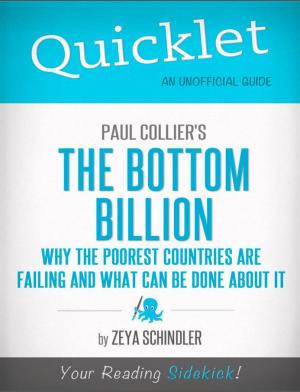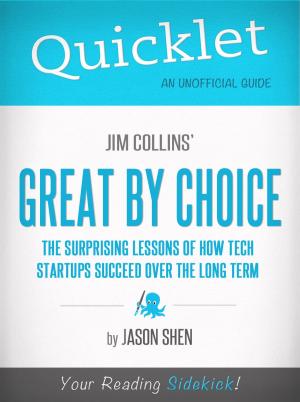Quicklet on Malcolm Gladwell's The Tipping Point: How Little Things Can Make a Big Difference (CliffNotes-like Summary and Analysis)
Nonfiction, Reference & Language, Study Aids, Book Notes, Art & Architecture, General Art| Author: | Scott James | ISBN: | 9781614646815 |
| Publisher: | Hyperink | Publication: | July 30, 2012 |
| Imprint: | Hyperink | Language: | English |
| Author: | Scott James |
| ISBN: | 9781614646815 |
| Publisher: | Hyperink |
| Publication: | July 30, 2012 |
| Imprint: | Hyperink |
| Language: | English |
ABOUT THE BOOK
"The world of the Tipping Point is a place where the unexpected becomes expected, where radical change is more than possibility."
Malcolm Gladwell's The Tipping Point: How Little Things Can Make a Big Difference is an irreverent, fresh look at why some things become trends and others don't. We are all familiar with and a part of trends, fads, and cultural shifts, but often we don't understand them. It's easy to understand why specific things happen in our own lives, but most of us just stare off into space and shake our heads when we happen to think about why some shirt is in style or why a neighborhood is getting more dangerous. We don't know because there are too many moving parts to think about.
In this book, Gladwell zooms in on the relatively microscopic people, aspects, and conditions that spread those trends. He uses the overarching metaphor of an epidemic as a visualization of how ideas spread. Do you know why suddenly some video of a little kid is everywhere on the Internet, or why Harry Potter became the most popular book in the world? Malcolm Gladwell thinks he does.
For most of us, trends and ideas are just things that happen around us. Much of what Gladwell is doing makes causes and effects that are too big to think about more human and personal. In that way, he gives us something to grab hold of. It's as if he is taking massive spreadsheets and computer models of information and explaining them to you at a cocktail party over a martini. It works and he makes a lot of sense. Sitting there reading it over you'll think, "Yeah, of course. I already knew that' which is always the mark of a good explanation.
Of course, it's impossible to ever know for sure why one fad happens and another doesn't make it out of the gate, but by the end of the book Gladwell has drilled down into the minutiae and created a compelling breakdown on how it generally works. We all understand things that we've never put into words quite succinctly. Gladwell is doing exactly that in this book. The strength of his pop science is that he gives concrete names to nebulous causes that create our world.
EXCERPT FROM THE BOOK
"The Tipping Point grew out of an article I wrote as a freelancer for Tina Brown at the New Yorker, who ran the piece and then - to my surprise and delight - hired me. Thank you, Tina."
Malcolm Gladwell is a prolific writer who lives in New York. His books and articles generate a lot of conversation and debate because they dig into highly contentious and often unanswerable issues. He is a special contributor to The New Yorker magazine, where he writes about things like the science of cool hunting, race and sports, physical genius, the concept of moral hazard and health care, and the difference between puzzles and mysteries. He has published several popular books, including Blink and Outliers.
His articles and books are often called pop science because he takes research, rearranges it, and uses it to draw new conclusions about why things happen in our world. Most often his topics are questions that can't be definitively answered or investigations of concepts that are unresolved while being somehow both common and mysterious. His writing is widely read and his breakdown of the "tipping point" concept has been widely referenced and utilized throughout marketing circles...
The revolutionary part of this chapter is that he actually pins down the right size of a group to make it the most productive. He takes a deep look at Gore, a fabric innovation company. The company is divided into 150 or so person teams that are separated...
ABOUT THE BOOK
"The world of the Tipping Point is a place where the unexpected becomes expected, where radical change is more than possibility."
Malcolm Gladwell's The Tipping Point: How Little Things Can Make a Big Difference is an irreverent, fresh look at why some things become trends and others don't. We are all familiar with and a part of trends, fads, and cultural shifts, but often we don't understand them. It's easy to understand why specific things happen in our own lives, but most of us just stare off into space and shake our heads when we happen to think about why some shirt is in style or why a neighborhood is getting more dangerous. We don't know because there are too many moving parts to think about.
In this book, Gladwell zooms in on the relatively microscopic people, aspects, and conditions that spread those trends. He uses the overarching metaphor of an epidemic as a visualization of how ideas spread. Do you know why suddenly some video of a little kid is everywhere on the Internet, or why Harry Potter became the most popular book in the world? Malcolm Gladwell thinks he does.
For most of us, trends and ideas are just things that happen around us. Much of what Gladwell is doing makes causes and effects that are too big to think about more human and personal. In that way, he gives us something to grab hold of. It's as if he is taking massive spreadsheets and computer models of information and explaining them to you at a cocktail party over a martini. It works and he makes a lot of sense. Sitting there reading it over you'll think, "Yeah, of course. I already knew that' which is always the mark of a good explanation.
Of course, it's impossible to ever know for sure why one fad happens and another doesn't make it out of the gate, but by the end of the book Gladwell has drilled down into the minutiae and created a compelling breakdown on how it generally works. We all understand things that we've never put into words quite succinctly. Gladwell is doing exactly that in this book. The strength of his pop science is that he gives concrete names to nebulous causes that create our world.
EXCERPT FROM THE BOOK
"The Tipping Point grew out of an article I wrote as a freelancer for Tina Brown at the New Yorker, who ran the piece and then - to my surprise and delight - hired me. Thank you, Tina."
Malcolm Gladwell is a prolific writer who lives in New York. His books and articles generate a lot of conversation and debate because they dig into highly contentious and often unanswerable issues. He is a special contributor to The New Yorker magazine, where he writes about things like the science of cool hunting, race and sports, physical genius, the concept of moral hazard and health care, and the difference between puzzles and mysteries. He has published several popular books, including Blink and Outliers.
His articles and books are often called pop science because he takes research, rearranges it, and uses it to draw new conclusions about why things happen in our world. Most often his topics are questions that can't be definitively answered or investigations of concepts that are unresolved while being somehow both common and mysterious. His writing is widely read and his breakdown of the "tipping point" concept has been widely referenced and utilized throughout marketing circles...
The revolutionary part of this chapter is that he actually pins down the right size of a group to make it the most productive. He takes a deep look at Gore, a fabric innovation company. The company is divided into 150 or so person teams that are separated...















